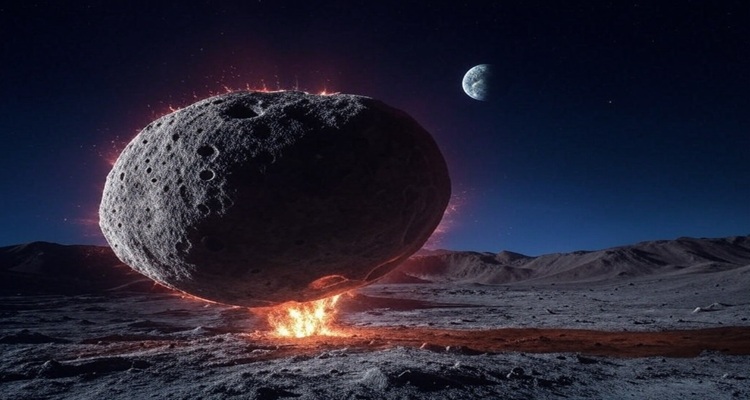Asteroid Impact Carved Massive Lunar Canyons in Minutes

A colossal asteroid impact 3.8 billion years ago created two Grand Canyon-sized trenches on the moon in mere minutes, reshaping lunar history.
A Cataclysmic Impact That Reshaped the Moon
The Grand Canyon, a geological marvel on Earth, took millions of years to form through gradual erosion. But on the moon, an entirely different process led to the creation of two equally massive canyons—within just ten minutes. According to new research, an ancient asteroid impact near the moon’s south pole unleashed an explosive force, carving out these immense trenches almost instantaneously.
Unraveling a 3.8-Billion-Year-Old Lunar Mystery
Scientists studying the Schrödinger impact basin, a vast crater on the moon’s far side, have identified two deep canyons—Vallis Planck and Vallis Schrödinger—believed to have been sculpted by high-speed debris ejected from a cataclysmic collision. The asteroid or comet responsible for this event, estimated to be about 15 miles (25 km) in diameter, struck the lunar surface with an impact equivalent to 130 times the current global nuclear arsenal.
The study, led by geologist David Kring of the Lunar and Planetary Institute in Houston, sheds light on how such violent impacts shaped the moon’s surface. Published in Nature Communications, the research utilized data from NASA’s Lunar Reconnaissance Orbiter and sophisticated computer modeling to reconstruct the aftermath of the colossal strike.
Mapping the Moon’s Massive Trenches
The newly mapped canyons stretch across the moon’s rugged terrain, with Vallis Planck measuring about 174 miles (280 km) long and plunging to depths of 2.2 miles (3.5 km). Vallis Schrödinger, slightly shorter at 168 miles (270 km), reaches depths of 1.7 miles (2.7 km). These massive formations extend outward from the central impact crater, marking the landscape with deep, linear scars that contrast with the moon’s more common circular craters.
A High-Speed Debris Avalanche
Using advanced modeling techniques, researchers determined that debris from the impact traveled at blistering speeds of up to 2,200 miles per hour (3,600 km/h). The forceful ejection of lunar material triggered secondary impacts, further deepening and widening the canyons within minutes. Unlike the slow and steady erosion that shaped Earth’s geological wonders, these formations resulted from a sudden, violent bombardment.
A Legacy of Solar System Chaos
This event occurred during a period known as the Late Heavy Bombardment when the inner solar system was under siege by wandering asteroids and comets. Scientists believe this chaotic era was triggered by shifts in the orbits of Jupiter, Saturn, Uranus, and Neptune, destabilizing space rock trajectories, and sending them hurtling toward planetary surfaces.
Interestingly, the asteroid that carved these lunar canyons was even larger than the one that struck Earth 66 million years ago, wiping out the dinosaurs. However, unlike Earth—where plate tectonics constantly recycle the surface—the moon retains scars from these ancient impacts, offering a preserved history of early solar system events.
Why This Matters for Lunar Exploration
The discovery of these canyons holds significant implications for future moon missions, particularly NASA’s Artemis program. With plans to land astronauts near the lunar south pole, the Schrödinger basin is a prime target for exploration.
According to Kring, the impact debris from Schrödinger would have scattered ancient lunar rocks across the region, placing valuable geological samples within easy reach of future astronauts. These samples could help test prevailing theories about the moon’s origin, including the hypothesis that it formed from a giant impact between Earth and another celestial body.
Looking Ahead: The Moon as a Scientific Archive
As space agencies plan for lunar bases and long-term exploration, understanding the moon’s geological history becomes increasingly vital. The moon’s ability to preserve evidence of early solar system events makes it a crucial site for studying planetary evolution. By examining canyons like Vallis Planck and Vallis Schrödinger, scientists can gain insight into not just the moon’s past, but also Earth’s—and by extension, the broader history of our solar system.
The next decade promises exciting discoveries as robotic and human missions return to the moon, potentially uncovering more remnants of ancient impacts that shaped our celestial neighbor. For now, this study provides a remarkable glimpse into a world where landscapes were sculpted not by wind and water, but by the raw, unrelenting force of cosmic collisions.
Source: (Reuters)
(Disclaimer: The information in this article is based on publicly available research and scientific findings. As lunar exploration advances, new discoveries may refine or expand upon these insights. For the latest updates, refer to official sources such as NASA and peer-reviewed scientific publications.)
Also Read: Ancient Antarctic Bird Sheds Light on Modern Avian Evolution









